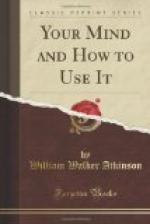After observing the stress laid, throughout this book, upon the necessity for logical associations, you will readily see that the key-note to note-taking is, Let your notes represent the logical progression of thought in the lecture. Strive above all else to secure the skeleton—the framework upon which the lecture is hung. A lecture is a logical structure, and the form in which it is presented is the outline. This outline, then, is your chief concern. In the case of some lectures it is an easy matter. The lecturer may place the outline in your hands beforehand, may present it on the black-board, or may give it orally. Some lecturers, too, present their material in such clear-cut divisions that the outline is easily followed. Others, however, are very difficult to follow in this regard.
In arranging an outline you will find it wise to adopt some device by which the parts will stand out prominently, and the progression of thought will be indicated with proper subordination of titles. Adopt some system at the beginning of your college course, and use it in all your notes. The system here given may serve as a model, using first the Roman numerals, then capitals, then Arabic numerals:
I.
II.
A.
B.
1.
2.
a.
b.
(1)
(2)
(a)
(b)
In concluding this discussion of lecture notes, you should be urged to make good use of your notes after they are taken. First, glance over them as soon as possible after the lecture. Inasmuch as they will then be fresh in your mind, you will be able to recall almost the entire lecture; you will also be able to supply missing parts from memory. Some students make it a rule to reduce all class-notes to typewritten form soon after the lecture. This is an excellent practice, but is rather expensive in time. In addition to this after-class review, you should make a second review of your notes as the first step in the preparation of the next day’s lesson. This will connect up the lessons with each other and will make the course a unified whole instead of a series of disconnected parts. Too often a course exists in a student’s mind as a series of separate discussions and he sees only the horizon of a single day. This condition might be represented by a series of disconnected links:
O O O O O
A summary of each day’s lesson, however, preceding the preparation for the next day, forges new links and welds them all together into an unbroken chain:
OOOOOOOOOO
A method that has been found helpful is to use a double-page system of notetaking, using the left-hand page for the bare outline, with largest divisions, and the right-hand page for the details. This device makes the note-book readily available for hasty review or for more extended study.




